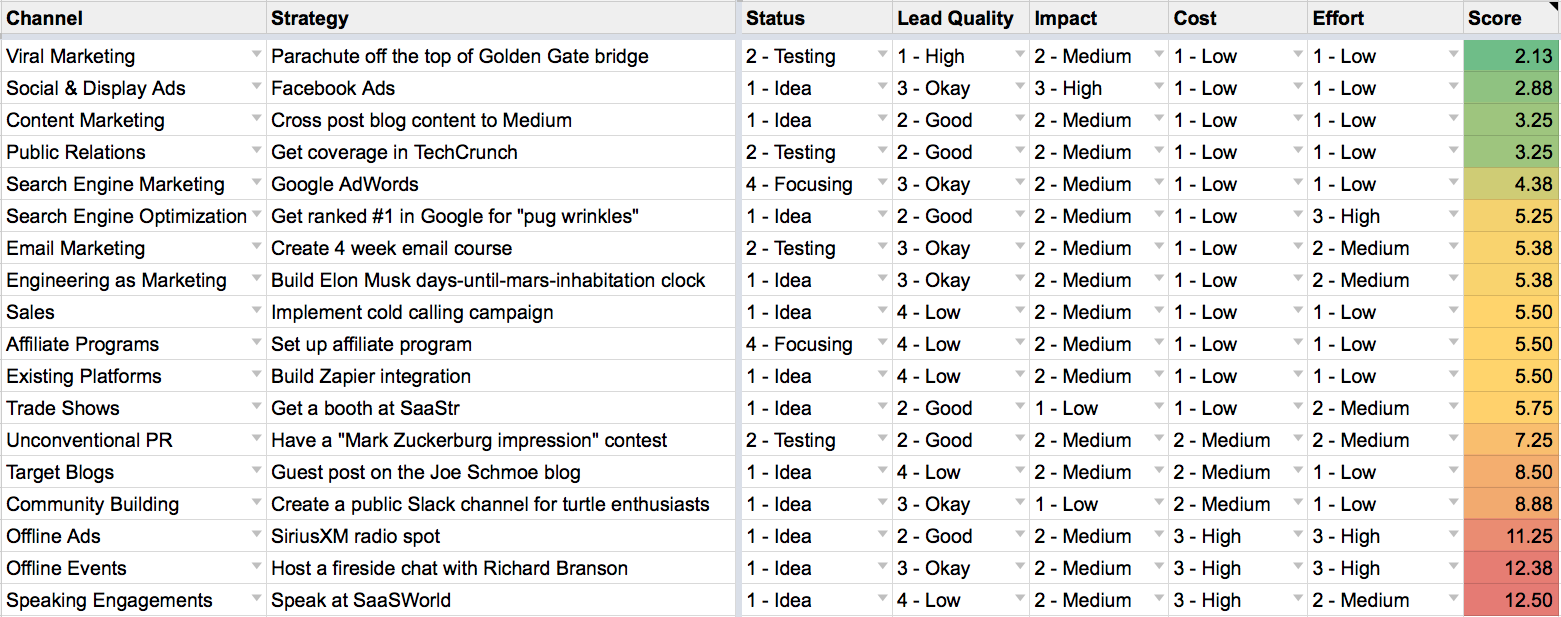Table of Contents

What if you could put a system in place that instantly scores and prioritizes any marketing idea you had? You could focus in on exactly the strategies that are most likely bring you a return on your effort while minimizing costs and increasing impact. #synergy amirite?!?
Lucky for you, we’ve got a system for doing just that, and I’ll walk you through how to set it up and get going today!
The implementation of this is in a Google Spreadsheet, which you’ll want to make a copy of to follow along. But, I’m getting ahead of myself!
Looking for traction
Earlier this year I read Gabriel Weinberg & Justin Mares’ Traction. It’s jam packed full of ideas for growing your business with a “3-step framework called Bullseye”. The framework really is great and got me thinking about all sorts of marketing channels and strategies I hadn’t considered before.
The book mentions using a spreadsheet to put all of your ideas in, categorizing them and tracking a few variables to prove their viability as a strategy, so that got my wheels turning.
I liked having a place to dump all the random marketing ideas. In a matter of minutes you can drum up dozens of ideas. But actually prioritizing what to go after first was much harder to come by. Given the size of our team (and that we don’t have a single person focused full-time on marketing) I wanted to be as efficient as possible with our time.
To prioritize our marketing efforts, I created a scoring system that instantly priorities any marketing idea you’ve got. It tells you right away what you should be testing out next. This lets you knock out some low hanging fruit right out of the gate and help kickstart your marketing plans!
Marketing Prioritization System
You’ll want to make a copy of this Google Spreadsheet so you can follow along.
At the basis of this is the Traction Bullseye framework, but we’ve added a full weighted scoring system on top of it to help prioritize what to go after first. I’ll walk you through the whole thing and then you can jump right in and start using it, or tweak to your heart’s content.
Channel + Strategy
The Channel column is for choosing one of the 19 channels mentioned in Traction.
- Targeting Blogs
- Public Relations
- Unconventional PR
- Search Engine Marketing
- Social & Display Ads
- Offline Ads
- Search Engine Optimization
- Content Marketing
- Email Marketing
- Viral Marketing
- Engineering as Marketing
- Business Development
- Sales
- Affiliate Programs
- Existing Platforms
- Trade Shows
- Offline Events
- Speaking Engagements
- Community Building
It’s easy to write off some of these channels. “No way would a trade show ever work out for us!” But when you’re brainstorming ideas, it’s important to put it all out on the table. Mix in a scoring system for your ideas and magic!
The Strategy column is where your actual idea goes. The Channel is just for categorizing them.
Status
You’ll likely be going through multiple ideas as the same time, so the Status column helps you keep track of where you’re at with a given idea.
It’s options are Idea, Testing, Focusing, Abandoned.
Testing
After you’ve come up with a marketing idea, you need to test that strategy to see if it’s viable and cost effective. You’re basically starting with an educated guess on this.
Not all ideas are testable or even repeatable in any sort of scalable manner, but if they are, there are a number of additional data points you’ll want to track.
- Customer Acquisition Costs (CAC)
- Response Rate
- Conversion Rate
- Customer Lifetime Value (LTV)
These are numbers you can make educated guesses on from the start and then update as a test progresses. This can help you prioritize and purge ideas, especially when it comes to the economics of things.
LICE: Lead Quality, Impact, Cost, Effort
Now that we’ve established some baseline data points for you to collect and input as you’re creating ideas, lets look at the meat of this: scoring.

Scoring here lets you quickly identify what you should try out next based on four factors.
- Lead Quality
- Impact
- Cost
- Effort
LICE makes everything nice. 🙂
We use these four factors to generate a score where the lower the number, the more accessible the marketing idea is. Let’s take a look at the four factors.
Lead Quality
Not all sources are created equal. Usually your highest quality leads will come from a source that sends you the lowest number of leads and the lowest quality leads will come from a source that just hammers you with traffic.
Your AirBnB for Hamsters service may get lots of traffic from TechCrunch, but lets be honest…very few of those visitors will, you know, need that. But a writeup from Petco?!?! Those leads would be fantastic!
Impact
Impact will, many times, match up to your Lead Quality, but it’s geared more towards what the purpose of your marketing is. For instance, maybe brand awareness is a much larger focus to you as opposed to lead generation. In that case, a marketing idea could have a lower lead quality score but a high impact score.
Cost
Not all great ideas are expensive (in fact, many times your best ideas are actually dirt cheap). But the fact is, some ideas really can be pretty expensive (trade shows, advertising, sponsorships).
If cost isn’t a big factor for your company, you can lower the weight of the “cost” in the final score (which I’ll talk about momentarily).
Effort
How much work will this idea take? Does the idea rest on convincing someone else to do something? Does the whole team need to get involved to pull off the idea? All of those things affect how much effort something takes.
Multipliers
Every company is in a different stage and what factors have an impact on you will vary. Maybe you’ve got all the time in the world but no money…that makes cost a huge multiplier. Maybe you’ve got limited time but lots of money, in that case effort would be a big multiplier.
In the Settings for the system, you can set multipliers on all four variables to adjust importance.
The Score
Once you’ve set Lead Quality, Effort, Cost and Impact (and adjusted the various multipliers) what you get is weighted score that helps guide what marketing ideas you should try next!
The lower the score, the more in line the idea is with the current stage of your company!

Putting in to practice
Using the Marketing System spreadsheet, you should be able to start scoring your marketing ideas instantly. It works right out of the proverbial box.
I suggest jumping in and doing a brain dump of everything you can think of and then let the scoring system do its work.
Don’t overthink the ratings you assign to a given idea, just go with your gut. This system obviously doesn’t actually do the marketing for you…it’s here to help you know what to go after next. If you don’t actually put it in to practice, you’ll be no better off!




